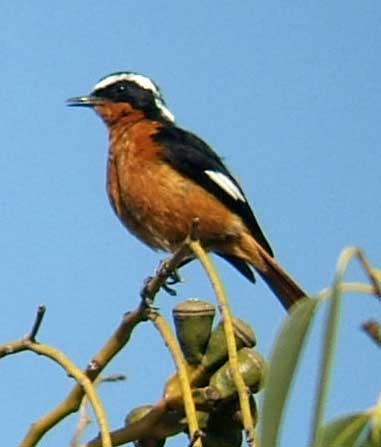Phoenicurus moussieri (*) Cladus: Eukaryota Name Phoenicurus moussieri (Olphe-Galliard, 1852) Vernacular names Ελληνικά : Φοινίκουρος του Άτλαντα Reference Annales des Sci. Phys. et Nat., d'Agric. et d'Industrie, publ. par la Soc. Royale d' Agric. &c. Lyon (2) 4 p.101 pl.2 The Moussier's Redstart (Phoenicurus moussieri) is a small passerine bird in the genus Phoenicurus (redstarts), formerly classed as a member of the thrush family (Turdidae), but is now classified as an Old World flycatcher (Muscicapidae). It is an endemic resident breeder in the Atlas Mountains of northwest Africa. Its habitat is open woodland in rocky areas from sea level up to 3000 m altitude in the mountains.[1] It is the smallest redstart, only 12 cm long and 14–15 g weight. The male has a black head with a broad white stripe running above each eye and down the side of the neck. The upperparts are black other than a white wing patch, and the rich chestnut tail, from which it and other redstarts get their names (start is an old word for tail). The underparts are a rich orange-red. The female has a pale brown head and upperparts, and the underparts are a paler orange than the male, although generally redder than the underparts of the similar but larger female Common Redstart.[2] Behaviour The male's song is a mixture of rasping sounds and svee-svee notes. The call is a plaintive single note, wheet. It is primarily insectivorous, often feeding like a flycatcher, making aerial sallies after passing insects, but also picking and even digging insects out of the ground; more rarely, it will eat small berries. Its nest is built in a bush or on the ground and the clutch is typically 3-6 eggs.[2] Although largely resident, some show limited migratory behaviour, particularly altitudinal migration by those breeding at high altitudes moving to lower levels in winter.[1] Vagrants have reached north to Great Britain (Dinas Head, Pembrokeshire; April 1988[3]), east to Greece,[2] and south to Mauretania.[4] Taxonomy Its relationships are obscure; its biogeography is not matched by any other redstart, while its colour pattern is most similar to the much larger Güldenstädt's Redstart, which shares the conspicuous white wing patch of the male. It was not included in the study by Ertan (2006),[5] while in the limited sampling by Sangster et al. (2010) it was closest to Common Redstart.[6] References 1. ^ a b Hoyo, J. del, et al., eds. (2005). Handbook of the Birds of the World, vol. 10. Barcelona: Lynx Edicions. pp. 773. ISBN 84-87334-72-5. Source: Wikipedia, Wikispecies: All text is available under the terms of the GNU Free Documentation License |
|

